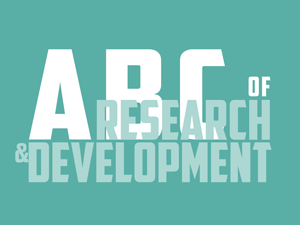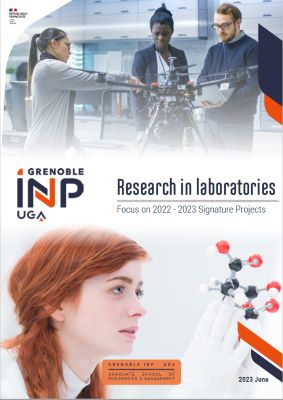
Article written by Isabelle Chéry and Gaëlle Calvary
The valorisation of public research is defined as the means of “making the results, knowledge and skills of research usable or marketable”. Transfer is the final stage of the transmission process to a third party. It may be motivated by a desire to exploit or defend.
As a reminder, there are two classic ways of transferring knowledge:
- The “market-pull” development carried out in partnership with companies. Research is focused on solving a specific problem submitted by the company. Here, the innovation is co-constructed on the basis of market needs previously identified by the company. The aim of this collaborative research is to improve knowledge in the field and, if possible, to lead to advances that will enable the company to stand out from its competitors. These results may be protected by intellectual property (software, brevet) or by secrecy (know-how) and will be the subject of a transfer contract to the company.
- “Techno-push” development is rooted in innovative research results obtained internally in laboratories. Here the invention is “pushed” towards the market. The objective is to identify relevant applications and determine the most suitable structure for supporting the innovation and developing the market: an existing company or the creation of a dedicated company (start-up/spin-off often Deeptech). To do this, the valorisation process consists of de-risking the transfer of the result to the socio-economic environment through key stages:
- Protect the research result according to the nature of the result and the intellectual property (IP) rights it may generate (patent, software, know-how, etc.),
- Pre-mature the result by developing a proof of concept that makes the result concrete. This stage can be carried out in parallel with the protection or successively if, typically, additional experiments are necessary for the drafting of a patent application. The objective of this phase is to identify the problems solved by the technology and the major potential application fields. The rise in technological and market maturity is respectively from TRL 2 to TRL 34 and from BRL 1 to BRL 3,
- Mature the result by transforming the proof of concept into a “market” demonstrator. The demonstrator is produced in accordance with a specification drawn up with companies’ representative of potential customers, identified by a market study. This document specifies the targeted uses or applications as well as the standards and regulations in force in the corresponding application fields. Intellectual property (improvements or new IP) is consolidated. The ramp-up in technological maturity is from TRL 34 to TRL 5-6. The ramp-up in market maturity is from BRL 4 to BRL 6 corresponding to the market segmentation and strategic positioning choice.
- Transfer the result by signing a transfer or exploitation contract with an existing company or via the creation of a start-up. The transfer will allow the industrialisation and marketing of the result, which corresponds to a change in market maturity from a BRL 7 to a BRL 9. The result goes from the prototype stage to pre-series, which corresponds to a leap in technological maturity from a TRL 67 to a TRL 9.
In market-pull and techno-push, the transfer is formalized by a contract allowing the company to exploit the results protected by IP rights or formalized by know-how: this is the transfer contract. It can take different forms depending on the transfer strategy and the agreements made with the company, especially when the transferred Intellectual property is the result of a research collaboration contract. Thus, the transfer contract may take the form of a licensing agreement (called direct licensing), a co-ownership and exploitation contract or an assignment contract. The negotiation of the transfer contract concerns several points, including the financial counterparts (i.e., exploitation returns to the result holders). Unlike market-pull valuation, where the company has the necessary expertise and knows the market, techno-push valuation requires pushing the result to the market and requires a long investment. In this case, the signing of the contract does not finalise the transfer: it is essential to support the transfer to increase industrialisation chances and marketing the innovation. On the one hand, this support can be provided by the people behind the invention (mechanism of the law on innovation for public laboratories researchers).
On the other hand, the transfer can be accompanied by a research collaboration contract with the laboratory (collaboration contract, joint laboratory, consortium agreement, etc.) at the origin of the invention in order to continue the developments. These collaborations feed the virtuous circle of valorisation with new funding for the laboratory, improvements or new inventions for the company, the recruitment of young graduates, etc.
In techno-push, two transfer routes can be envisaged: the creation of a start-up or the transfer to an existing company.
1. Creating a start-up
If the researchers behind the innovative result or if an external carrier (e.g., a post-doctoral student who has participated in the maturation process) are motivated to create a start-up and if the target market is large enough to support a new structure, then creating a company is possible.
To make this new structure reliable, it is important to be accompanied by incubation professionals before creating the company in order to build a Business Model (BM) and a Business Plan (BP). The Business Model describes the general logic of the start-up's project, i.e., its strategy for making money. It explains how the company creates, delivers and captures value. The business plan explains the operational implementation (company strategy, manager's vision, team, market, etc.) and figures (projected balance sheet, projected income statement) of the business model. The incubation phase works on all the points that make the BM and BP more reliable:
- Design the future startup's offer by producing pre-series (TRL 6-7 to TRL9),
- Identify the product/market pairs and their prioritisation,
- Secure intellectual property through freedom of exploitation studies,
- Strengthen the entrepreneurial team and the distribution of roles/missions, capital and power,
- Set up the legal documents necessary for the creation of the company and its contractual relations of all kinds (operating contract, key contracts with partners),
- Communicating in order to access the clients and partners of the future start-up (development of identity and notoriety, etc.),
- Structuring the financial aspects of the business plan in order to mobilise the appropriate funding and attract investors.
Once the start-up has been created, it can be supported by other structures such as accelerators, business incubators, the Entreprendre network, etc. It can also be housed in the laboratory where the invention originated in order to benefit from the infrastructure such as the technical platforms.
2. Transfer to an existing company
If the market is very targeted and there is not enough space to support a new structure or if there is no desire on the part of the researchers or an external carrier to create a start-up, then the choice is made to transfer the research result directly to one or more existing companies, depending on the transfer strategy. The companies likely to integrate the technology were identified by the market study conducted during the maturation phase. However, it is difficult to find industrial partners for techno-push development and it is often necessary to continue prospecting for industrial partners. To identify potential new targets in the targeted fields of application, it is necessary to rely on a solid network and on the major patents owners via patent databases. The Internet, professional networks, trade fairs and conferences are all possible sources of contacts and information.
The choice of the company that will ultimately integrate the result depends on its skills and its financial capacity to put the invention on the market. Exchanges with the company will take place under a confidentiality agreement. In general, before the transfer is finalised, a licence option is signed and a feasibility study conducted between the original laboratory and the target company. The study aims to ‘de-risk’ the transfer for the company by confirming its interest or not.
Sometimes, the creation of a start-up and existing companies are combined to maximise the impact of the innovation: the start-up valorises the result in a targeted field and existing companies make it fruitful outside the start-up's field.



